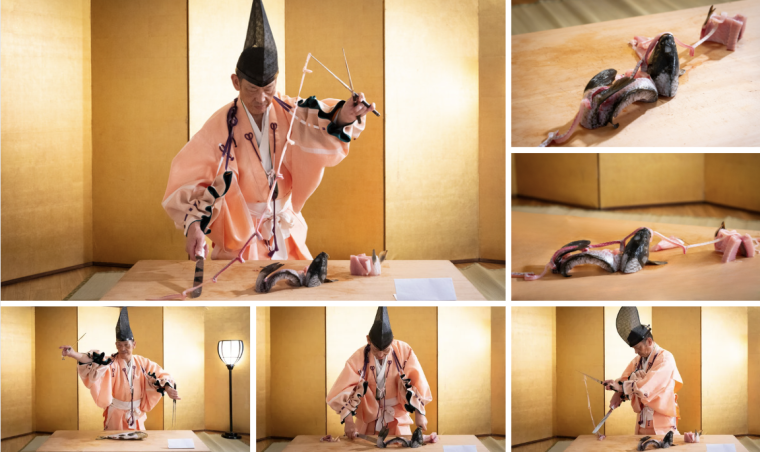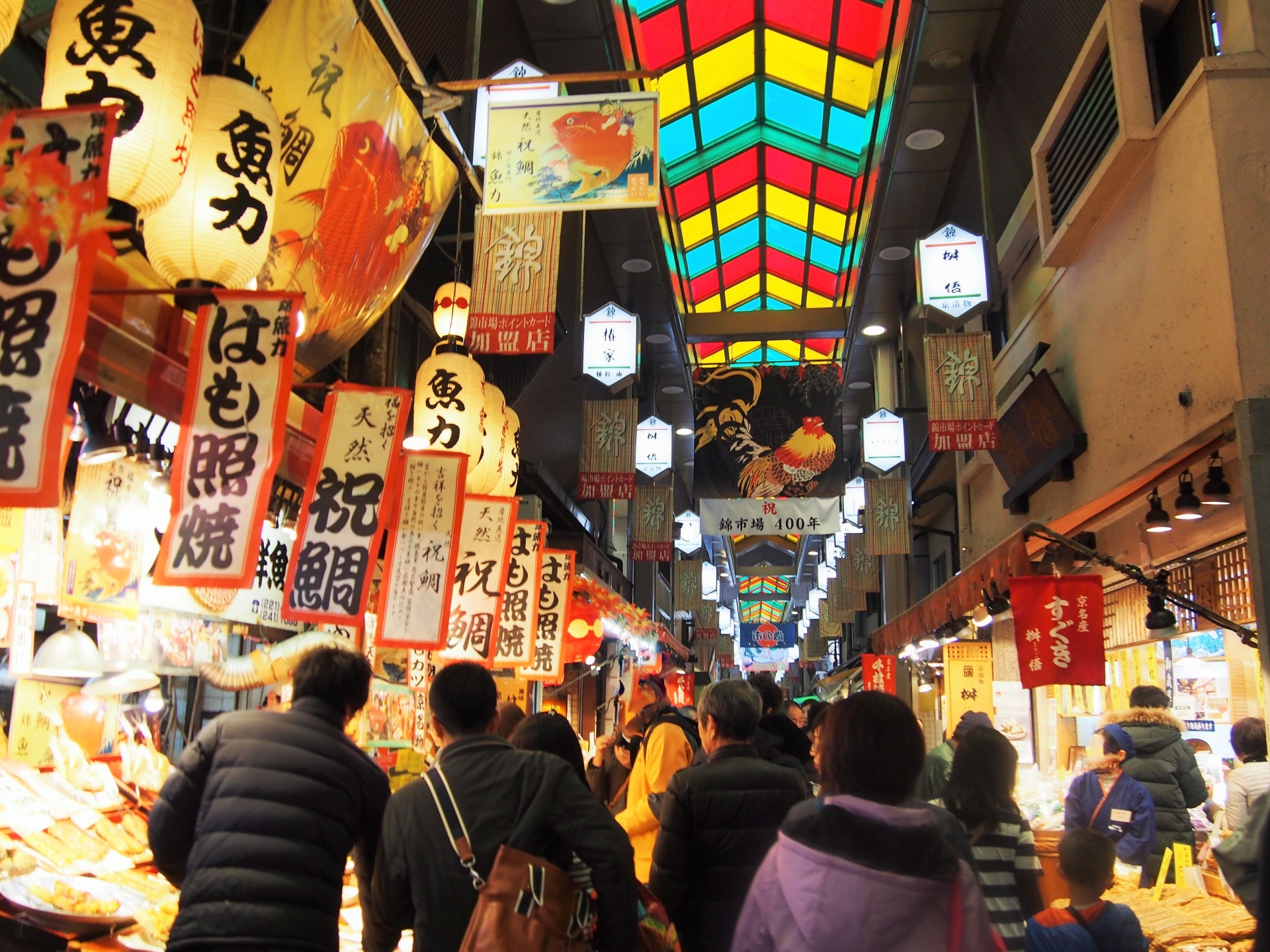Nishiki Market
Kanae Nakahama
Latest posts by Kanae Nakahama (see all)
- Gion and Geisha Districts in Kyoto - 2017/09/22
- Geisha Show In Kyoto - 2017/09/04
- Maiko And Geisha With No Makeup (Sendo-mairi) - 2017/07/10
Nishiki Market
Nishiki Market is known as Kyoto’s kitchen. That is because of the variety of shops and the history of Nishiki Market. The length of Nishiki Market is only 390m. However, a special atmosphere is made by the energy of people who work there, and the history of Nishiki Market. You can feel the history of the market by walking by. Talking about Nishiki Market, the history of this market is old. It is told, Nishiki Market used to start as a fish market around 782-805. The underground water and convenience for the access made the shops increase into varieties. Until 1054, the Nishiki Market was called Gusoku-koji. The emperor Goreizei changed the name to Nishiki-koji.
■ Nishiki Tenman-gu Shrine
Before walking to Nishiki Market, right in front of it there is Nishiki Tenman-gu Shrine in Shinkyogoku shopping street. This shrine was made in 1003, which is dedicated to Sugawara no Michizane; the god of learning.
The cow will welcome you inside. It is told, if the person strokes the cow’s head you will get clever.
This shrine is also famous for water. Nishiki Market was made very close to this shrine because of the great quality of water. Even now, people come to draw water from the well into their plastic bottles.
Nishiki Tenmangu Shrine is a very unique place. This robot tells the history about the shrine and market with picture cards for about 5 minutes.
There are other differences in this shrine. This mechanical doll does the fortune telling.
There are varieties of fortune telling.
The shishi (lion) carries the oracle.
I tried the flower oracle. It was written in Engish and Japanese.
People can take the oracle home. Yet, if the oracle is not good or you don’t need it, you can tie it up at here.
There are other types of mechanical doll oracles. It depends which machine you choose, but it costs ¥100 or ¥200.
Beautiful flowers to rest yourself.
Before going to Nishiki Market, maybe a short visit at Nishiki Tenmangu Shrine might be a nice trip to have.
■ Nine Selected Shops In Nishiki Market
Talking about Nishiki Market, there are tons of variety of shops. At this report, I’d like to introduce the unique shops I found.
■ Octopus Dipped In Soy Sause
This is one of Nishiki Market’s specialty. This style of serving octopus was recently made, but it is now a new symbol in this market. Tiny octopus are dipped into soy sauce.
The price changes by the size.
Inside the octopus there is a boiled egg in it. This was made for eating out. The octopus was chewy, and the egg inside was a good accent.
■ Tofu (Soybean Product) Shop
This is a shop that mainly sell products that are related to soybean. This soybean donut is one of the foods that you can’t miss it at this market. It is not too sweet, and not glittery at all so you can eat more than you are imaging of. Soybean donut is also suitable for eating out.
■ Fresh Seafood
If you are tired walking around, try this shop. This shop is unique because there are no room to go inside the shop. The chairs are outside facing the shop. You can enjoy fresh seafood. At this shop, roasted daggertooth pike with ume (Japanese apricot) sauce is popular for connoisseurs.
Oysters can be eaten raw at this shop too. You can enjoy it with lemon sauce or soy sauce with citrus juice.
■ Japanese Pickles Shop
Around thirty types of pickles are sold at this shop.
There are lots of pickles, you might have difficulty to choose the pickles you like.
■ Sun-show Pepper Shop
Sun-show pepper is a traditional Japanese spice. The smell of the spice is near lemon. At this shop they recommend using this spice for chicken food. Sun-show also matches hot meals, such a bowl of broiled eel and boiled rice.
The woman was grinding down the nut to make this spice. You can taste it and experience what it tastes like. A grain of pepper may be tiny, but gives a sharp accent in your mouth.
After graining, she was sweeping it from the plate and gathering it together.
■ Original Hichimi Shop (seven blended spice)
This is a shop that you can make original shichimi at the moment. By choosing from twelve spices, an original spice is made.
■ Japanese Chestnut Shop
A full of Japanese chestnuts catched the people passing by. These Japanese chestnuts are roasted, and they taste very rich and smooth.
There are free Japanese chestnuts to try. Even just watching the process is enjoyable moment.
■ Peanut & Traditional Kyoto Style Confectionery Shop
Talking about Japanese chestnuts, there are also peeled peanuts for sale. At this shop there are free peanuts to try too. Comparing the peanut from your country might be another way to enjoy.
At the same shop, there were cute jellys. These jellies are half dry confectionery, and this is one type of traditional Kyoto style confectionery. It is made by agar, and it expresses the elegance of the four seasons in Kyoto.
■ Candy Shop
This might be a good souvenir to take home.
These types of candy are named, Kintaro-ame (candy). First of all, Kintaro is mainly recognized as the main character in one of the Japanese old tales. A candy company in Tokyo made a motif of this boy in Meiji period. From that day, this candy is well known as Kintaro-ame. These days, there are variety of types of this candy; such as famous cartoon characters, flowers, and words.
Not only Kintaro-ame, the style of candy culture are changing. There was a sushi and bento (Japanese style of home packed meal) made of candy. These are only candy, so it does not taste like feel fish or rice. It is just a delicious candy. However, the candy was made very real. Even though you stomach is full, just watching these make you feel hungry again.
■ In The End
Walking around and watching shops were very stimulating. Nishiki Market is loved by the locals and the people who come to visit. It is a market that protects the history, but also flexible by challenging for new activity. If you are tired, getting energy from a market that is full of energy might recover your travel fatigue.
Exploring Nishiki Market offers a dive into Kyoto’s culinary heart, with its diverse array of traditional foods and goods. Complementing this gastronomic journey, the “Hochoshiki Knife ceremony” presents a unique opportunity to witness the exquisite craftsmanship behind Japanese knife-making, enhancing the appreciation for the culinary artistry found in markets like Nishiki.
https://www.hochoshiki-knifeceremony.com/

A sacred place for Japanese food, a treasure house of ingredients, Minami-Boso Takaya Shrine Kitchen knife ceremony "Ryumon-no-Koi" long story: edited by Minamiboso City Tourism Association Channel

